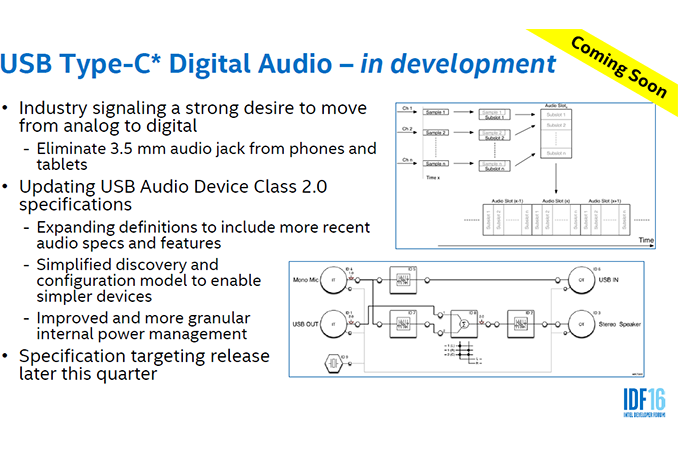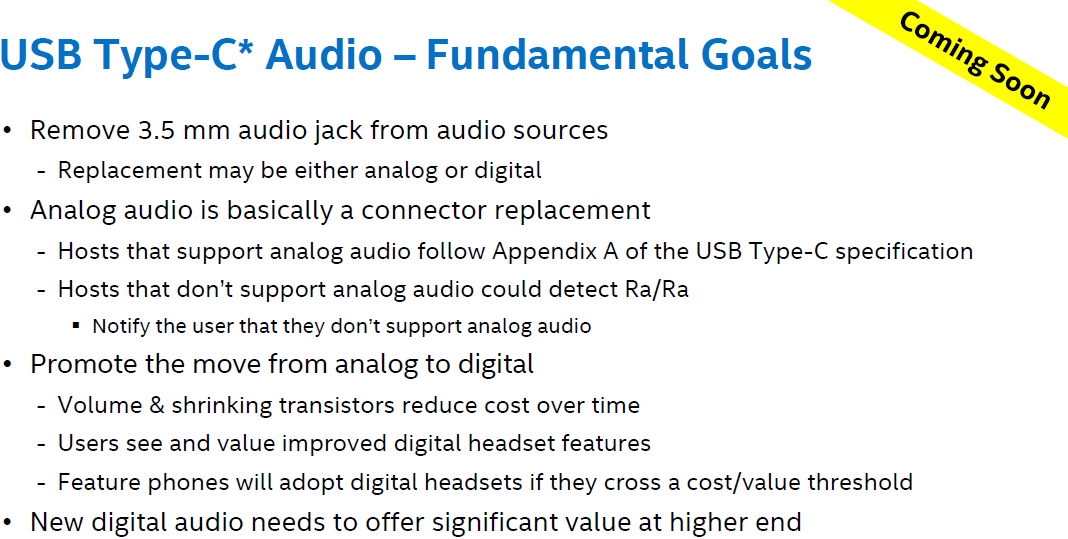Intel Proposes to Use USB Type-C Digital Audio Technology
by Anton Shilov on April 26, 2016 11:00 AM EST- Posted in
- Mobile
- Intel
- USB-C
- USB-C Digital Audio

USB Type-C has a number of chances to become the standard for data and charging connector for smartphones and tablets running either Android or Windows. However, in the long-term future, Intel wants USB-C to be even more universal (and therefore pervasive) than it is going to be, which is why at IDF Shenzhen part of one of the talks evolved around using Type-C for audio.
Audio receptacles on PCs and mobile equipment are virtually the last remaining analog interfaces of modern devices, requiring certain techniques to maintain a high audio quality and remove interference. Intel proposes to replace things like 3.5 mm mini-jack with USB Type-C which will help to add features to headsets and will simplify connections of multi-channel audio equipment to various gadgets. This is not the first time a company has proposed to replace analog audio on PCs and mobile devices, but so far, nobody has succeeded due to the ubiquity of 3.5mm. Since the industry may still not be ready to go all-digital, there seems to be a backup plan.
Various types of audio jacks to connect headphones to audio equipment have been around for decades. For example, the original 6.35 mm connector, which is still widely used by audio equipment, was invented in 1878. Meanwhile, two-conductor miniature 3.5 mm audio connector (which is the most widely used audio connector at present) has been around since 1960s. Headphone jacks have evolved; they have gained contacts to support microphones and even basic programmable capabilities to enable remote controls. However, fundamentally, the ability to listen to audio through a speaker has remained the same for over a hundred years: completely analog and barely any smart functionality. Today's smartphones are used for all sorts of different purposes and are connected to a variety of devices, which requires sophisticated interconnection technologies with high data-rates. At the same time, as phones and devices get thinner, or even to simplify some of the internal design, it gets harder to install multiple ports for various purposes. If there were to be a universal connector that does it all, including audio, Intel and some other players want USB Type-C to be that universal connector.
In fact, USB-C can be used to transfer analog audio in accordance with the specification of the connector. It all comes down as to how that audio is transmitted.
The USB-C has sideband use pins (SBU1 and SBU2) which can be used for analog audio in audio adapter accessory mode. Use of the sideband pins should not impact data transfers and other vital functionality of USB-C cables, which should make them relatively simple from the engineering point of view. In this case, the USB-C connector will just replace the 3.5 mm mini jack and may even gain some additional features, such as a thermal sensor in an earpiece could measure temperature for fitness tracking.
The concept is not completely new and we saw it years ago - back in the 2000s, Motorola used the mini-USB connector on its feature phones to enable charging, data transfers and a headset connection. The idea to use one connector for everything was not entirely bad, however, it left users without a choice of headsets. However, if the makers of devices (as well as producers of audio listening equipment) adopt USB-C, the is potential that the problem will not occur again. In the advent of digital signal transfer, this allows the headset to drive the digital-to-analog conversion, removing electronic interference from the host and potentially offering a wide array of audio results.
However, transferring analog audio using USB-C’s SBU pins is not the only thing that Intel is working on.
At present, Intel is finalizing the USB Type-C Digital Audio technology and plans to release its specification later in Q2. The company does not reveal a lot about the standard right now, but notes that it is working on updating the USB Audio Device Class 2.0 specifications to support new connector, expand the list of recent audio specifications and features, improve power management and simplify the discovery and configuration model to make the upcoming headsets as easy to use as today’s headsets.
In fact, one of the important issues with streaming audio over USB is the synchronization of data streams from the host to the receiver. The USB Audio Device Class specification solved the problem in the past and because Intel mentioned the USB Audio Device Class 2.0 in its presentation at IDF, this may mean that the new the USB-C Digital Audio spec will rely on this synchronization mechanism as well. Intel wants its USB-S Digital Audio to be backward-compatible with USB Audio (1.0 and 2.0), but naturally plans to add support for new music formats.
Usage of digital audio means that headsets should gain their own amplifiers, DACs and various other logic, which is currently located inside smartphones. Intel proposes to install special multi-function processing units (MPUs), which will perform beam forming, noise suppression, acoustic echo suppression (AES), acoustic echo cancellation (AEC), non-linear processing and other operations. The MPUs will also support HDCP technology, hence, it will not be possible to make digital copies of records using USB-C digital headset outputs. It is unlikely that audio processing will be offloaded to external headsets completely, but the latter will clearly gain their own chips. This may, however, see a spike in cost, especially at the super-low end.
A good thing about USB Type-C headsets with MPUs is that they are going to be software upgradeable and could gain functionality over their lifespan. Intel admits that such MPUs will make digital headsets more expensive compared to analog devices, but high volumes and new process technologies will help to reduce the cost of digital headsets over time. In fact, USB Audio headsets and audio chips for them are not something completely new. For example, Plantronics Audio 655 DSP headset costs $49.99, whereas CMedia’s HS-100 chip for headsets is available $1. Therefore, from the cost perspective, digital headphones should not be too much more expensive in general. Meanwhile, Intel wants USB-C digital audio headsets to offer “significant value at higher end” and have improved functionality in a bid to become popular among consumers.
The industry has successfully replaced analog cables with HDMI for video equipment in the living room and in the coming years will retire the D-Sub interconnection for computer displays. However, audio jacks have survived multiple generations as other standards have changed. In fact, Intel itself eliminated analog audio jacks in its first-generation NUCs PCs, but had to return them in subsequent generations. With USB-C Digital Audio Intel may not be alone. Google’s Android 5.0 already supports USB DAC devices and thus digital headsets. Moreover, last week LeEco released several smartphones without audio jacks, so, there are attempts to eliminate them from mobile devices already. One maker will not make any difference, but a coordinated move by market leaders, such as Samsung, LG or HTC, could have a significant impact.
Source: Intel



















148 Comments
View All Comments
taisserroots - Saturday, April 30, 2016 - link
you missed the whole point of "cheaper"most prefer wired signal and many prefer earphones which do not have the space to accommodate this
pixelstuff - Tuesday, April 26, 2016 - link
I can see most consumers opting not to buy a laptop that doesn't also include analog audio ports. For the same reason that built-in blue-tooth hasn't already eliminated them.Impulses - Tuesday, April 26, 2016 - link
Like they stopped buying laptops without optical drives or full size ports? (Or replaceable batteries, storage, RAM, etc) No. Most consumers, in the long run if not largely in the short term, will flock to wireless solutions because it'll be the most natural solution.I'm not saying i agree or welcome this, but it's what's gonna happen. The midrange market is already all about wireless and the high end market is either not large enough to matter or they actually prefer and outboard solution anyway.
A bunch of cheapskates that want to cling to dollar store headsets are unfortunately not gonna stop this. The market WILL get fragmented by Type C and Lighting, and some devices will get unnecessarily more complex.
It'll be better in the long run, maybe, but it sure is gonna be messy in the interim.
cm2187 - Saturday, April 30, 2016 - link
Some people like to carry a headphone the size of two half watermelons. I do not. I like the tiny, in ear headphones that I can forget in my pocket. You are telling me these tiny things not only will have to be much bigger to contain blutooth, but will also need a battery I will need to babysit? I doubt I am alone of this opinion. An iphone that requires me to carry a watermelon in my bag is a non starter.taisserroots - Saturday, April 30, 2016 - link
the funny part is the tiny earphones suddenly having to accommodate all of this.Like there wasn't a reason why they were tiny and have their heaviest points at the driver
HomeworldFound - Tuesday, April 26, 2016 - link
I would genuinely like to see this work in the PC market because for me onboard sound has never been good enough. I sigh whenever I see or hear a Realtek solution. The transition through Optical to HDMI audio has been very annoying, for me it became a limitation rather than any kind of benefit.I would welcome one major standard across all devices with an emphasis on quality rather than low budget. The problems will come from the Sony factor, would they want this standard to happen or would they prefer to push more propriety audio technologies and formats?
taisserroots - Saturday, April 30, 2016 - link
oh god a voodoo believer, listen if they haven't implemented good DACs on expensive PCs (even though they have on desktop and some notebooks, only cheaper one's need to catch up, it's mainly the fact they are weakly amped) why would you think headphone manufacturers would care???3.5mm jacks are already a major standard
JoeThursday - Wednesday, April 27, 2016 - link
Anybody remember the USB headset on the Palm Treo 800? Probably not, because it was a dead end, it didn't sell, and the technology went nowhere. The audio was bad, the headsets were expensive, cumbersome, and not-compatible with better alternatives already on the market. In short, it had lots of disadvantages and no really compelling advantages. So, if a USB headset was a bad idea then, what's made it so much better of an idea today? I certainly can;t think of anything.adriangb - Wednesday, April 27, 2016 - link
Bluetooth headphones already have a built in DAC and are similarly priced as analogue counterparts. I see this being more of a problem for in-ear headphones, because of the size.damianrobertjones - Wednesday, April 27, 2016 - link
What I would like... Is for ALL Windows USB c devices to pass audio through the cable into any USB enabled car stereos.